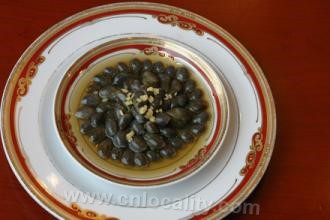welcomeSpecialty Foods Products!

Bullacta exarata is also very famous. The meat of Bullacta exarata is crisp and tender, and it does not contain mud (intestinal mud). It is plump and delicious. People often pickle it, especially the yellow snail in May and the osmanthus snail in August. The pickling method is: wash it with salt and plant ash, and then wash the ash in saliva. After five days of pickling, drain out the brine and boil it. After cooling and clarifying, reuse it, add a little salt and copy it for one month. Bullacta exarata, also known as Tutie, belongs to Gastropoda, Adirondaceae, and is a traditional product in the coastal area of Ninghai County. The mud snail is delicious and mellow, with rich nutritional value, and it is an excellent dish on the food table. At the same time, it is sweet and salty, cold in nature, and has the functions of nourishing the liver, benefiting the essence, moistening the liver, improving eyesight and promoting fluid production. In particular, the mud snail produced by our county magistrate's street town has the characteristics of tender meat, large body and soft tongue (no sand), which is particularly delicious and enjoys a high reputation in Shanghai, Ningbo, Hong Kong and Taiwan, and is called "Long Street Mudsnail". Bullacta changjie not only grows fast, but also is particularly fat. The big one is as big as fresh broad beans, and the small one is better than green beans. Generally, 160 to 170 grains are 0.5 kg. Two seasons can be harvested every year, namely, Bullacta exarata and Bullacta fragrans, and the former is of better quality. At present, Bullacta exarata is very popular in the market. The price of fresh 30 yuan per kilogram and salty 36 yuan per kilogram is four or five times higher than that of other sea areas. In the past, Bullacta exarata was collected from wild resources. In recent years, coastal farmers in Changjie area have explored and summarized new ways of artificially cultivating Bullacta exarata seedlings. They collect mud snail eggs (as big as table tennis balls, with tens of thousands of mud snail seeds observed by naked eyes) deeply embedded in mud coating, store water around the pond to prevent waves from incubating seedlings, and then put the mud snail into a clam pond, a clam pond or a special mud snail pond for stocking. According to statistics, the area of artificially cultured snails in Changjie area increased from 10 mu in 1989 to 3,200 mu in 1992. In 1997, the cultivated area reached 15,000 mu, producing 750 tons of fresh snails with an output value of 20 million yuan.
Reprinted with attribution:
https://cnlocality.com/(Chinese Specialty Products)
other
consult:(+86)13225231905